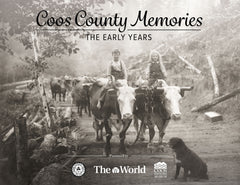
Wedding of Miss Coos Bay to Mr. Eugene Lane during the Railroad Jubilee, August 1916.
Courtesy Coos History Museum & Maritime Collection / #008-31.2
Early Panoramic Photography
While being able to capture a small frame was magic unto itself, a single photograph was not enough for early photographers to capture sweeping views of cities and landscapes.

Lookout Point at Bandon’s Coquille Point, including the U.S. Life Saving Service lookout and boathouse, circa 1914.
Courtesy Bandon Historical Society Museum
In order to fully capture the wider views, some of the first panoramic images were created by taking two or more images and placing them side by side.
As camera technology advanced in the late 1800s and photography moved from the glass-plated daguerreotypes to celluloid film, two types of panoramic cameras hit the market: swing-lens and 360-degree rotation cameras. Swing lens cameras, as the name would suggest, had the lens rotate while the camera body and film were still. Rotation cameras worked by having the camera body and film rotate to capture the image. These new panoramic cameras would create a perspective distortion as it panned across the subject. Large panoramic group photos were often taken with the subjects standing in a crescent shaped line to give the impression that the line was straight in the final image. If those at the first end were fast enough, they could run to the other end of the line and appear in the photograph twice.

The gas boat Queen became disabled on the Coquille River on July 16, 1914. The Life Saving Service crew went to her aid in the Defiance, but the tow line fouled the Defiance’s propeller, and both vessels stranded south of Bandon’s south jetty. Local men pitched in to re-float both vessels.
Courtesy Bandon Historical Society Museum
In 1913, F.W. Sheelor, a pioneer of panoramic photography, captured what was at the time the largest photograph at 12 feet, three inches long in Tonopah, NV. Sheelor also spent time in Oregon in the early 1900s creating large panoramas, including a 12-foot-long exposure of Portland. Panoramic photos could be produced in a variety of widths and lengths. Some commonly used panoramic cameras were capable of producing images up to 18 feet in length.

F. W. Sheelor, a pioneer of panoramic photography, took this photograph of Bandon’s harbor and mills from the water tower of Moore Mill.
Courtesy Bandon Historical Society Museum
Find more stunning photographs of historic Coos County in The World's new pictorial history book, Coos County Memories: The Early Years.

$40.45
$44.95